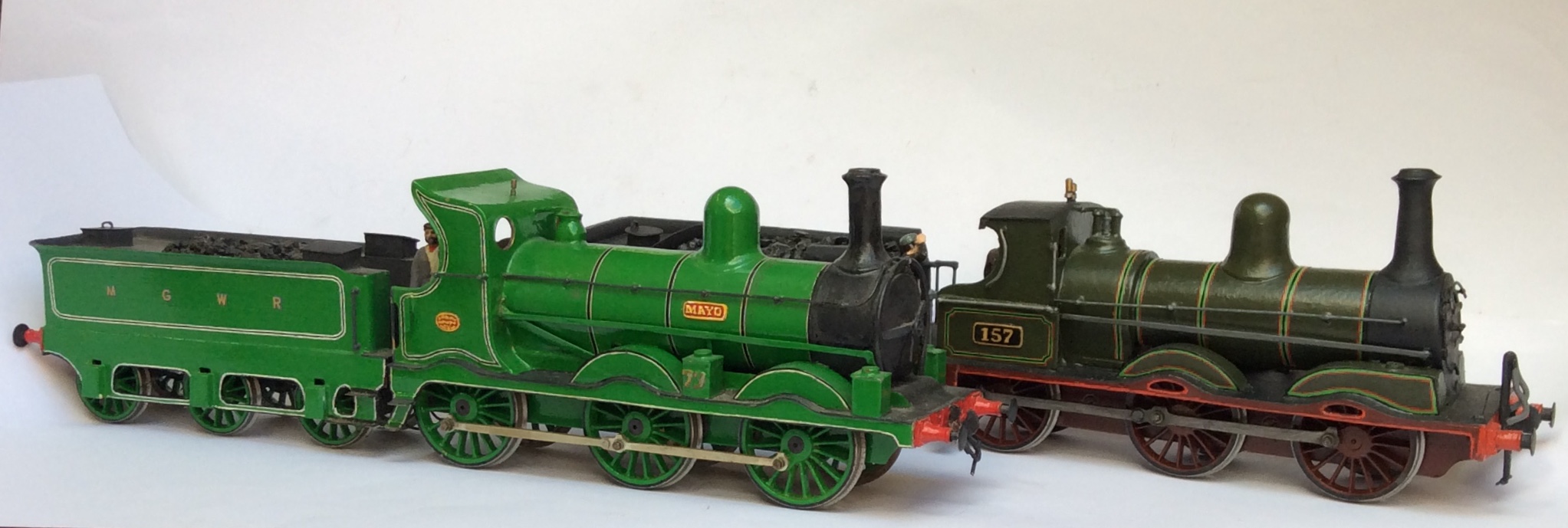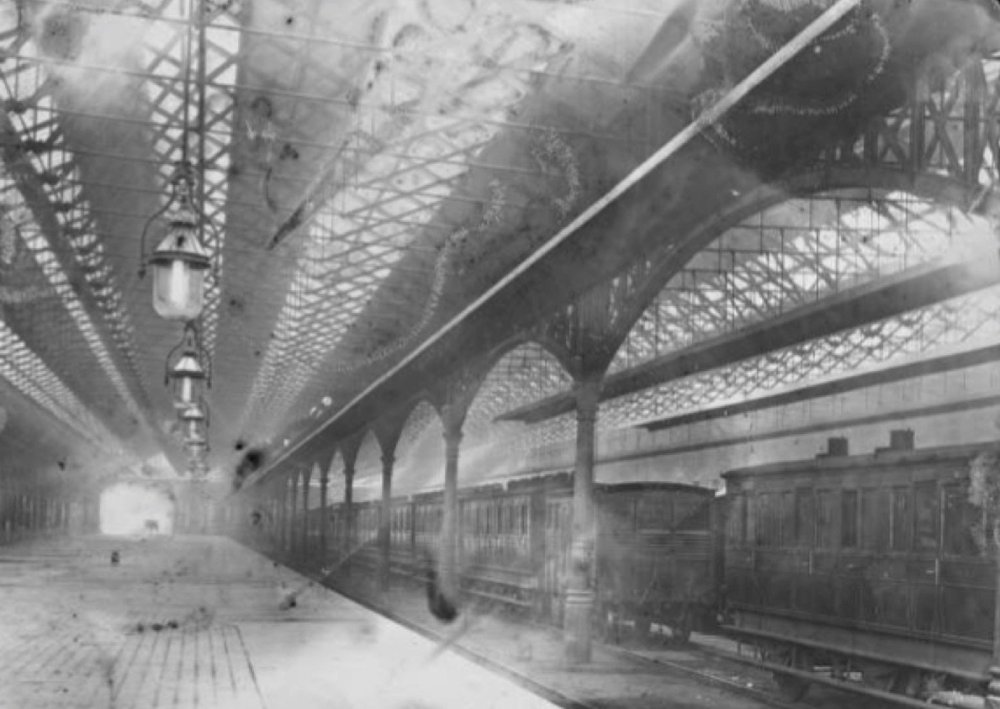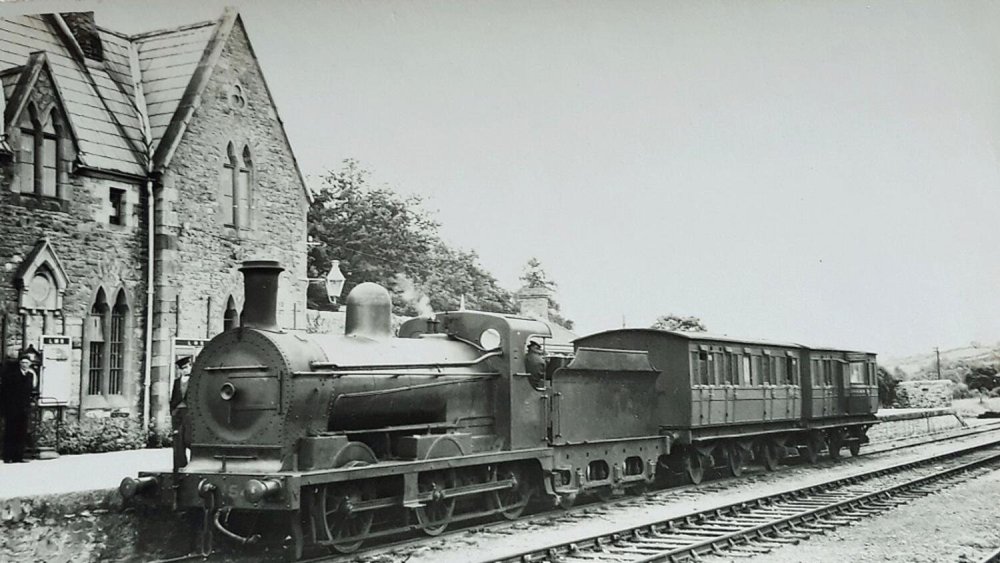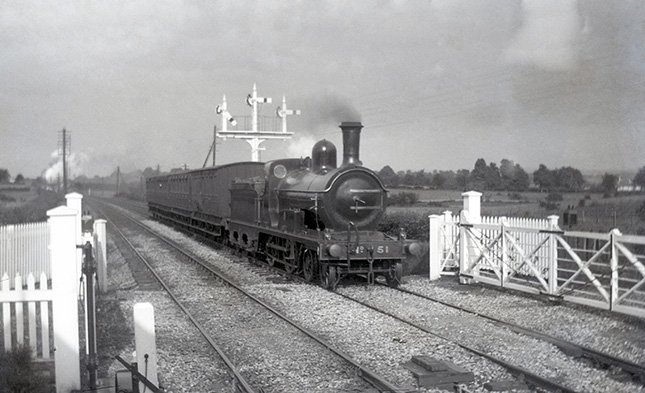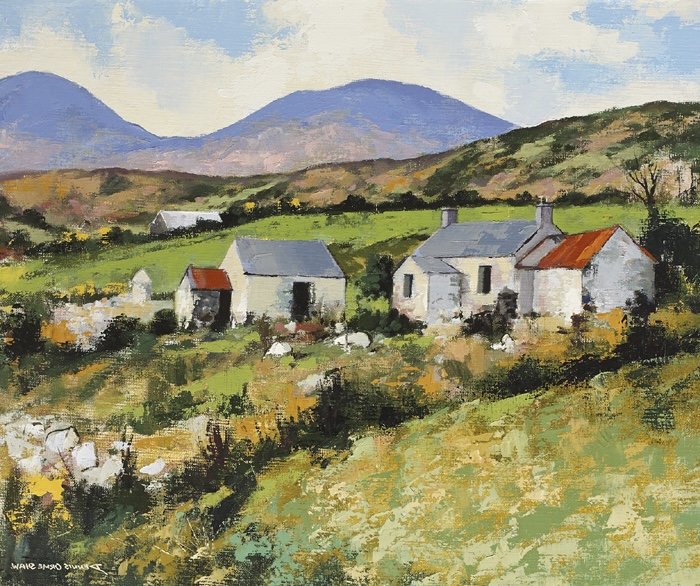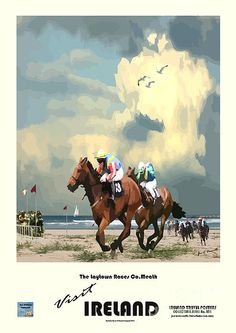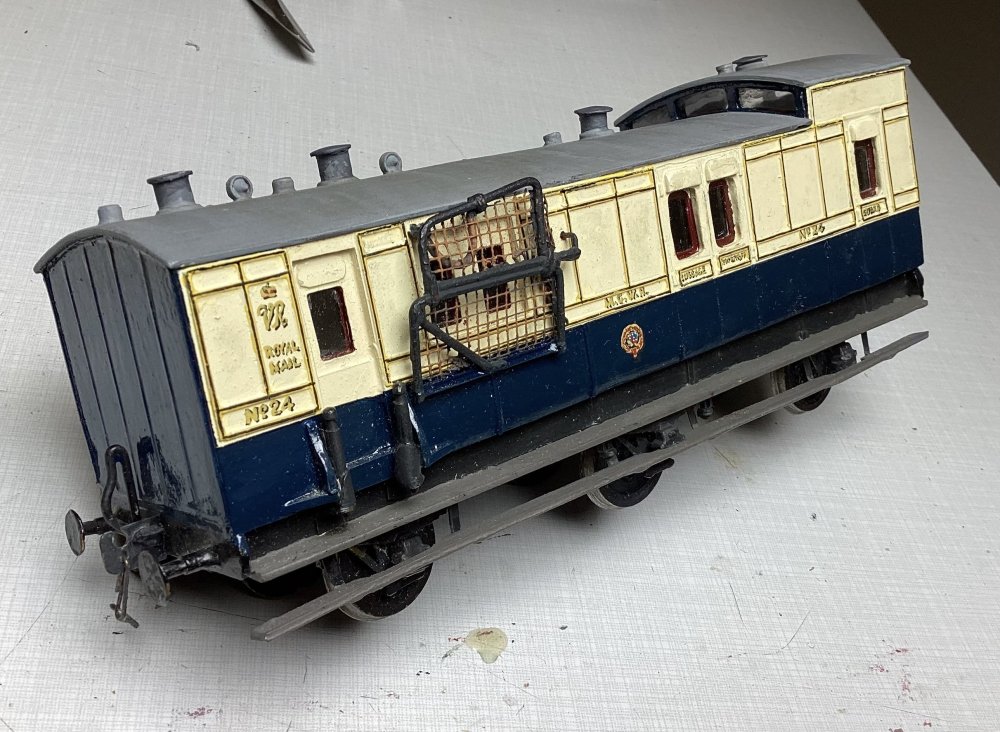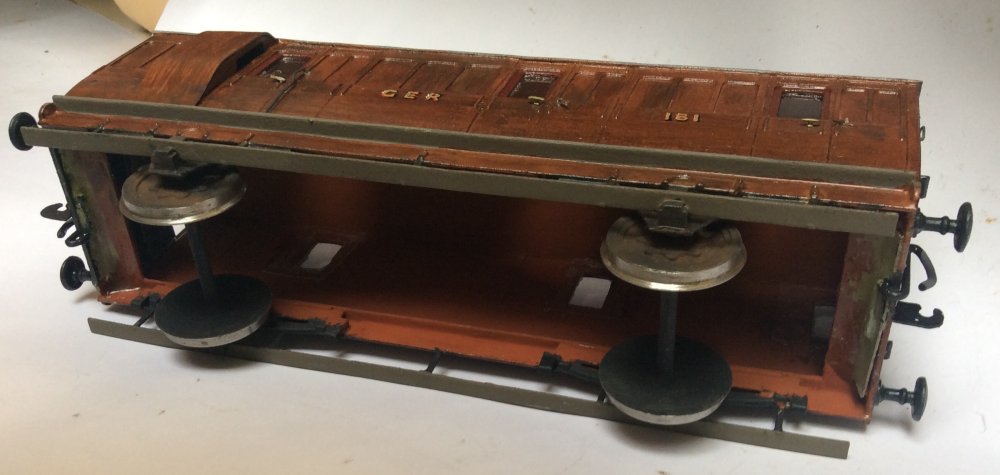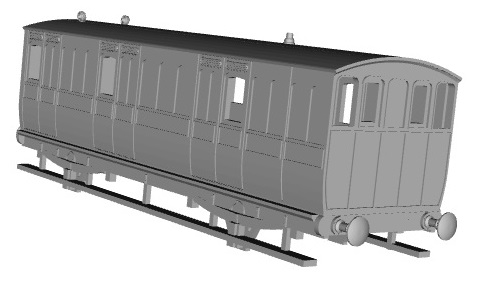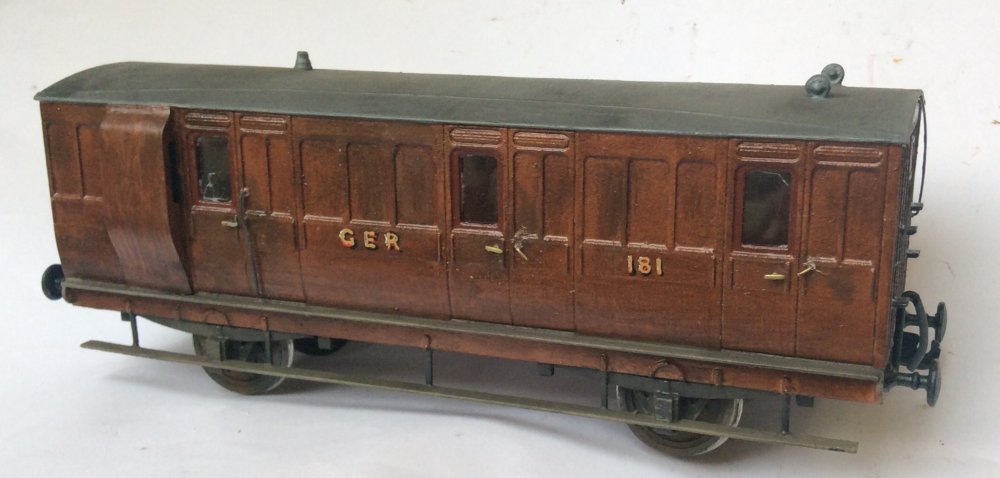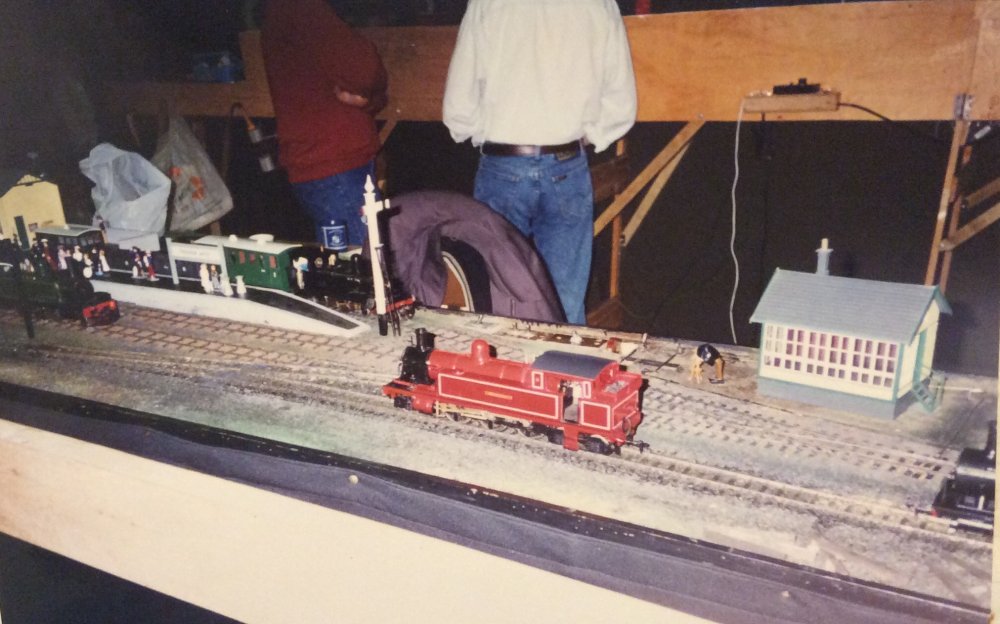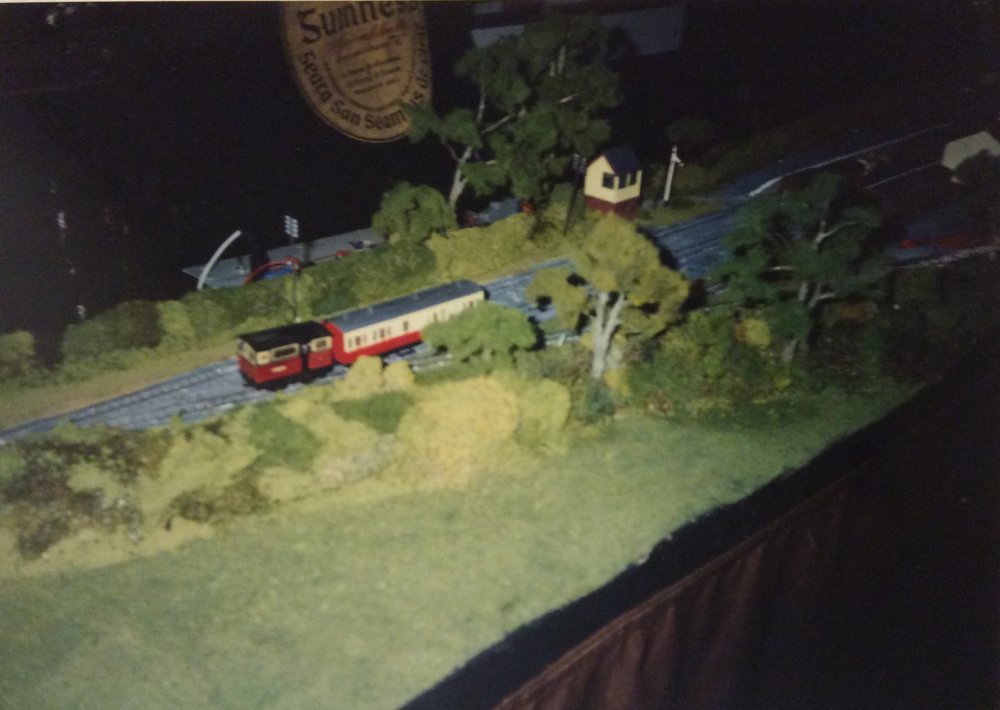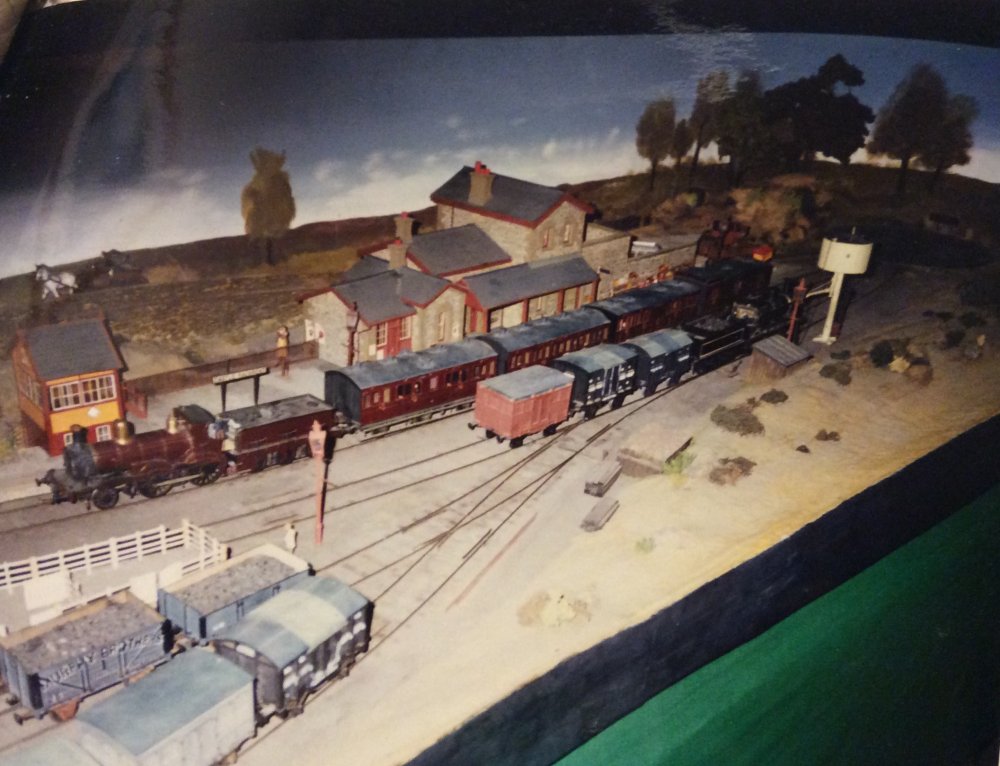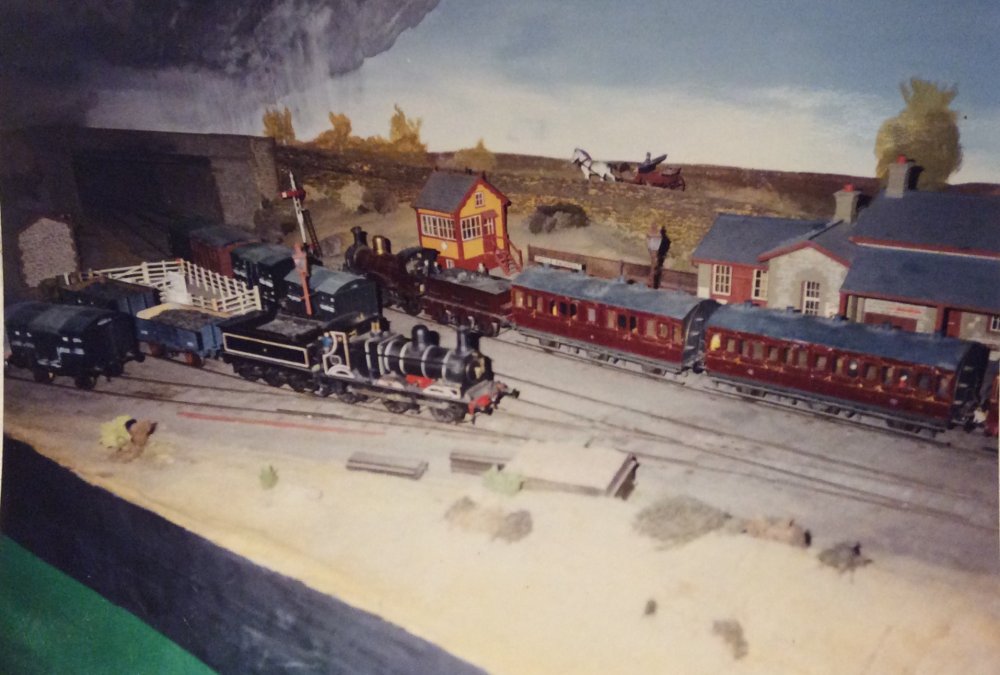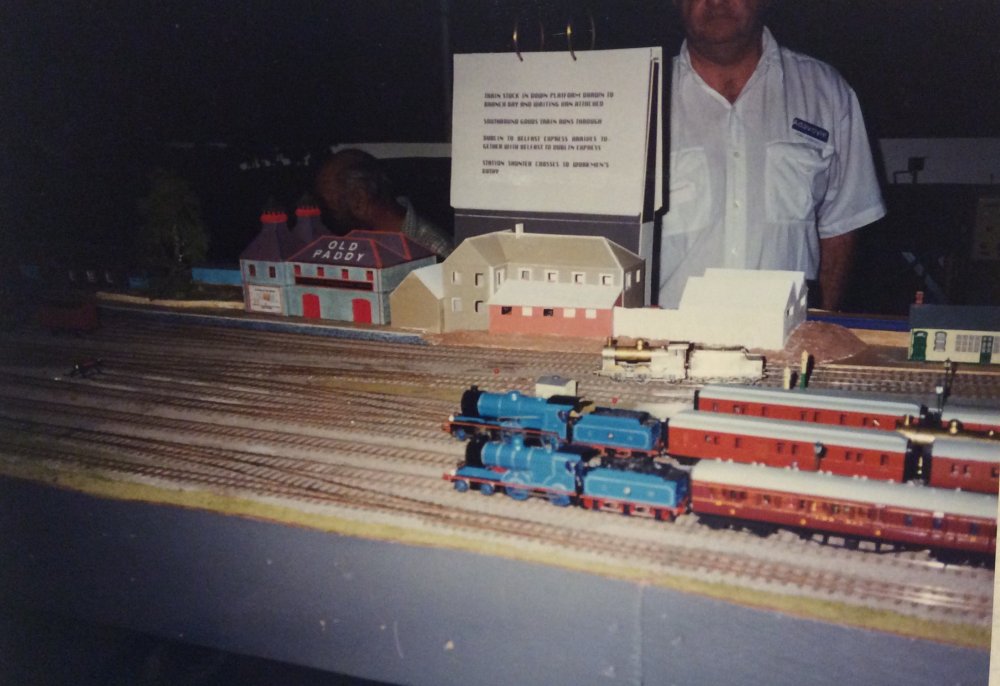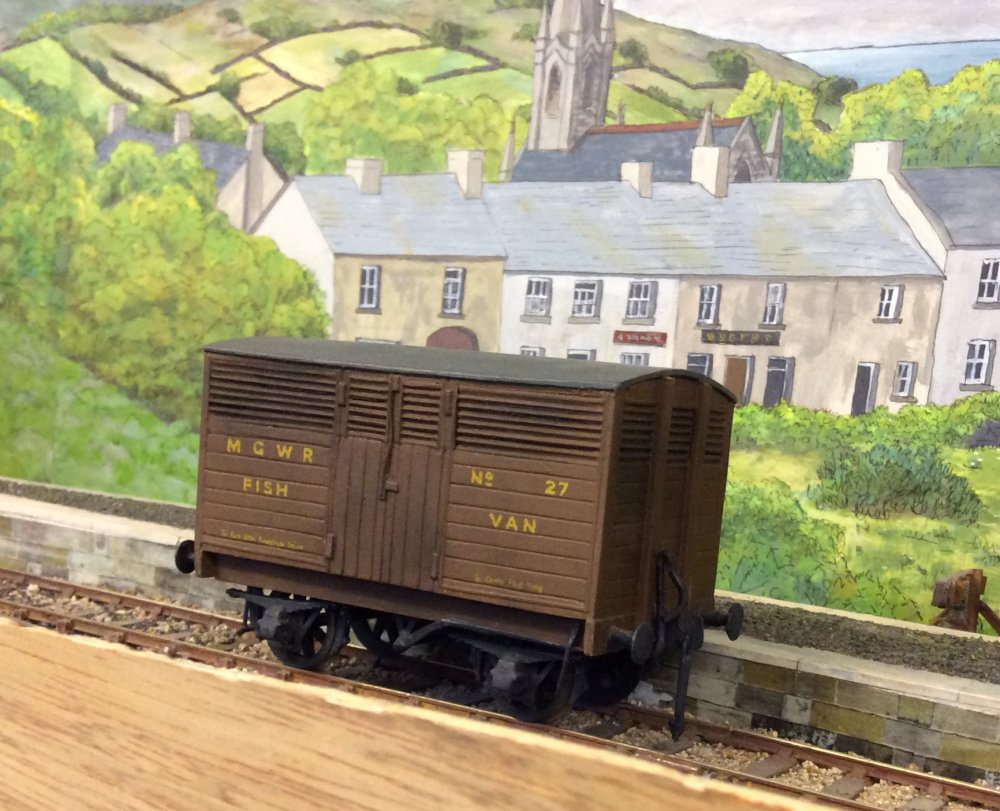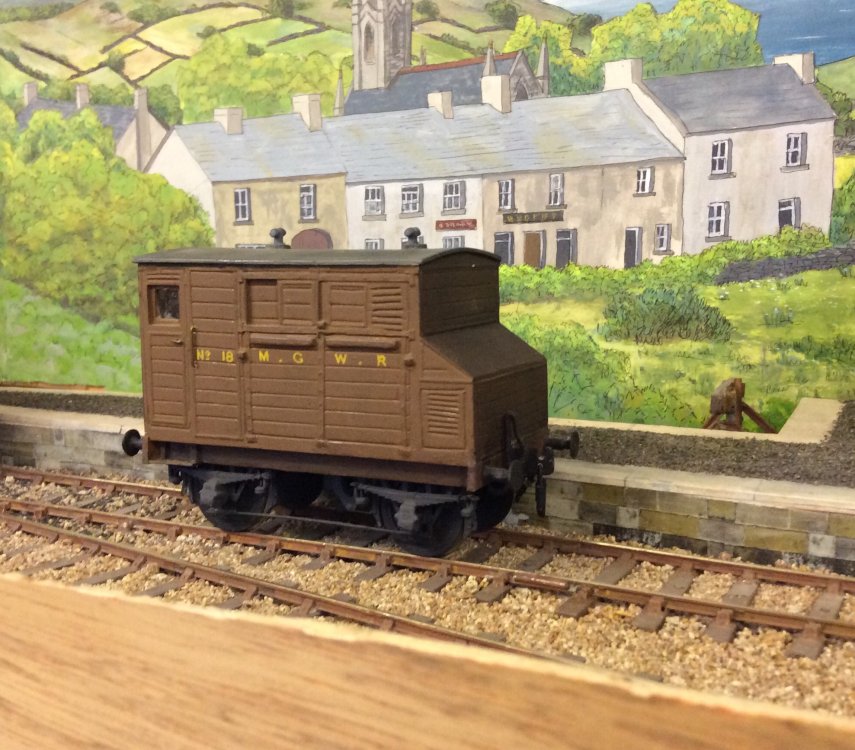-
Posts
334 -
Joined
-
Last visited
-
Days Won
2
Content Type
Profiles
Forums
Events
Gallery
Blogs
Community Map
Everything posted by Northroader
-
It’s fun when you start digging, isn’t it? Here’s the carriage sidings in the middle of Amiens Street in 1890, rather a cloudy image but given it's under a mucky old roof.. Definately oil lamps in use back then. The nearest coach is four compartments with a central luggage locker, composite or first? Then a ventilated van, which must be vac fitted for perishable traffic, then a six compartment third.
-
Thanks for your reply, Jonathan, I picked up on your mention of Cootehill, did an enquiry, and lo and behold! Six wheelers on the GNR in 1939! A composite lav., plus a full brake with an open door. Just the sort of train that’s needed:
-
I was looking at a shot of Knockmore Junction, and trying to work out the composition: they look like six wheelers, and there’s a full brake, and a six compartment third, (thanks, Niles, just like the one you’ve picked out) then two others. No oil lamp chimneys visible, was the GNR using gas or electric lights by then?
-
Just looking ahead at what I could be gainfully employed on in the future, and sizing up options available. I was wondering about an old GNR branch, pre 1900 setting, with a minimal amount of rolling stock. It struck me that I’ve seen hardly any photos of passenger trains for then, is there any information around at what Dundalk was doing before the bogie coaches were introduced? There’s some nice 3D prints produced for what was coming out of Doncaster, which could possibly be tweaked, main difference as far as I can see being a single radius roof instead of a “cove” roof.
-
There are toilets provided between the first and second compartments. it’s built with a strip of wood shaped to the roof profile, and a strip of wood for the floor, and blocks to keep ‘em apart. The build is heavy, too heavy, when Sylph is hitched to it and a brake third, there’s a lot of wheel spin getting the thing underway. don’t go out at night with it in your pocket, if you’re ‘stop and searched’ you’ll get done for carrying an offensive weapon.
-
French narrow gauge,, eh? There is a very tasty web site…… http://www.passion-metrique.net/forums/index.php
-
Thank you,Ken, really appreciate that, as I’m a big fan of your modelling output. For now everything’s boxed up, with a lot already moved on to my daughters as being less trouble, so all I can do for now is enjoy the websites, and doubtful if we’ll go for another couple of months yet. It’s time, isn’t it? My next models are sure to take a long time to appear, but everyone in contact is very firm about me keeping things going.
-
OK, mate, enjoyed having you and Linda. I’m interested to see how this will shape.
-
You never think of Americans doing shelf layouts, do you? It’s all damned great cavernous basements and tracks off everywhere, with a dozen guys to work it. Tell the truth and shame the devil, my copy of “Cameo Layouts” was last seen being packed in a cardboard box and going into a dealers van. (Mark Godding of Devizes, an online dealer, I’d best give him a plug, as he give me a fair price, I thought, and folks like Rail-Books didn’t want to know. https://www.mgoddingltd.co.uk) Theres a useful source of ideas for small lines here: https://micromodelrailwaydispatch.com some are a bit too much of a good thing, but I am drawing ways and means from there.
-
In between the family taking down furniture and me throwing things in the bin, I can’t help but have my mind turning forwards to what sort of a model layout could I do at the new place? It would be small, very small, it would be 7mm scale, because that’s what I like working in. It would be a micro layout, sort of a couple of lines fed from a fiddle stick. Pretty well all the micro layouts are wagon shunts, goods yard/ industrial sidings, but I do like to see a passenger operation as well, so a platform with some small station building in the mix. A running line and a siding to park a wagon would be alright. where and when and what? keep on pondering….. I think I’ve got the back scene sorted, though. (Lifted from an artwork and flipped, apologies to Dennis Orme Shaw, the artist, my intention is to use this as a basis to copy for my own paint job)
- 149 replies
-
- 10
-

-
Very good looking MGWR train. Being a dinosaur, I use an artists paint brush, dip it in a tin of Humbrol, and then put it on with a sort of brushing action. Spray cans??
-
You dreamt it. They were never that clean.
-
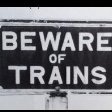
Clogherhead - A GNR(I) Seaside Terminus
Northroader replied to Patrick Davey's topic in Irish Model Layouts
-
Just harking back to pipe round the front of the smoke box on MGWR engines, (sorry I should have spotted this post at the time) I’m fairly certain it’s the train pipe for the vacuum brake, and it seems to be peculiar to the Midland engines, and Mr. Atock. There’s a swivel joint low down on the RHS, and the whole arched bit could swing forward. There’s a flexible hose dangling down on the LHS to connect with the bag on the rolling stock when the engines going backwards, though you can never find a photo showing this happening. Once the old boy retired, it looks like there was a move to replace this arrangement with the conventional swan neck in front of the buffer beam. Just guessing he must have felt that would get in the way of opening the smoke box door and shovelling ash out?
-
It’s a tea room, though! Alright, then, pack a few of me books, no modelling now until I get there, though, as it’s all packed away. Keep on IRM and enjoy the craic, though. Thanks, guys. Bob.
-
Thanks to everyone for the kind messages, it makes me realise what a great set of human beings are populating this web. For now we’re busy trying to get the clutter of a three bedroomed house downsized ready to go into a small bungalow. In connection with this if anyone is living near Wiltshire and fancies some none too good 7mm Irish models and some Irish railway books, all free to collect, they’re very welcome to call. Thanks again, Bob.
-
I’m afraid I haven’t done a post for a while, and what I was thinking about a couple of posts ago has moved forward. In March I had an Aortic aneurism, which has slowed me down some more. (Myself and my my daughter think that the surgeon leading the team that saved me, Mr. Wilson, had an Ulster accent, by the by) Anyhow, my wife and myself are downsizing to a small bungalow near my daughters in Cheltenham, and my modelling attempts sprawling in the loft are having to be drastically slimmed, as well as my book collection, which is my main job at present.
-
I did a MGWR mail coach in blue and white. Just a guess, I made a mix of Humbrol medium (French) blue 14 and midnight blue 15 This gives a decent shade, not too dark, not too light. (Goldilocks blue)
- 17 replies
-
- 10
-

-

-

-
I’d be inclined to advise fitting the footplate to the chassis as soon as it’s formed, and checking the slots clear the wheels all round, the siderods clear on rotation, then adding splashers and getting them clear of the wheels. Then go on to spectacle plate, tanks, etc.
-
I think you have to be careful to put a date on the horror stories you get about Shapeways, David, Something like 10 - 12 years back I was looking round the yearly Gauge 0 do at Telford, and there was a 3D printer on display. It was busily building up something or other all on its own, and I was fascinated by it. Later on I was seeing the results, and it was a bit of a let down, they were looking like 50 ply cowpats. That was then, this is now, the machines have been improved, print materials are better, know how and techniques are better. My own experience with Shapeways within the last two years has been a happy one. I bought one of the Rue d’Etropol’s range from them, he does a nice line in coaches for Colonel Stephens Lines, and I got a WCPR four wheel brake van, a GER cast off, in 7mm scale.(picture from the website) It came as a greyish white, slightly translucent finish, and a dusty sort of look. Reading up on threads about these jobs, they say wash it in warm soapy water, and rub the surface where there’s any banding with emery paper. I did a little bit of this on the roof, but none on the sides where it was barely visible. The recesses at the back of the axleguards were cleared out, and tophat bearings put in to take some Slaters wheelsets, and drawgear fitted. The lower footboards look vulnerable, and I took these off, and fitted brass strip replacements. The buffers were left, but this another thing which could become hors de combat. I wanted to put it back to GER condition, so I did new duckets in brass strip. Then undercoat, bodge a teak finish, and put some plastic sheet glazing. Here’s a couple of photos of the finished job, one taken from under which might give a good idea. in the 7mm size, so you may think it’s dear, but then, look at the clock on the wall. How long would it take to make a fully assembled coach with such detailed moudings on the panels?
-
Aahhh... the Chippenham show with the Irish theme, I had the good fortune to be there, Sunday I think i went, 29th October, 1995, taking totally rubbish photos, so if you’ll indulge me... “Castle Rackrent” of course, then... Tony Miles & co. “Adavoyle” P4. I reckon this layout was just about the smoothest running I’ve ever seen. Andy Cundick’s “Castlefinn” CDRJC 4mm scale. The Lepper families “Passage West”, 10mm scale, 32mm gauge, selection of Irish N.G. Locos. and stock. Paul Greene’s “Corcadoragha” S scale 63/64” gauge. There was some other stuff, like 0 gauge GWR, but you can see that all the time.
-
I was lucky enough to catch up with Castle Rackrent a long time back, on one of the rare times it came down from Scotland. Was it one of the first layout designs for the BLT/ fiddle yard format, and with a kickback to mask the fiddle yard? Then was Allendenac, with that huge viaduct. You had to marvel at the audacity of anyone building something that large, and bringing it to a show. I saw it at Telford, and thought it must have required a furniture van to shift it? There’s a nice write up with some good pictures here: https://highlandmiscellany.com/tag/richard-chown/
-

Horse transport and boxes on the Irish rail system
Northroader replied to Colin R's topic in Irish Models
Following up, here’s a MGWR horsebox, with a distinctive projecting end for the dogbox. There’s a good drawing in Ernie Shepherds book for this. -

Horse transport and boxes on the Irish rail system
Northroader replied to Colin R's topic in Irish Models
When the British army had cavalry exercises pre WW1, the officers horses tended to get proper horseboxes, and other ranks had cattle wagons. The other thing is I have heard it said that horses in cattle boxes tended to get discompooperated unless they were sheeted over, due to the country whizzing past. Proper horseboxes never had open spaces or windows in the horse compartments.
.png.c363cdf5c3fb7955cd92a55eb6dbbae0.png)
